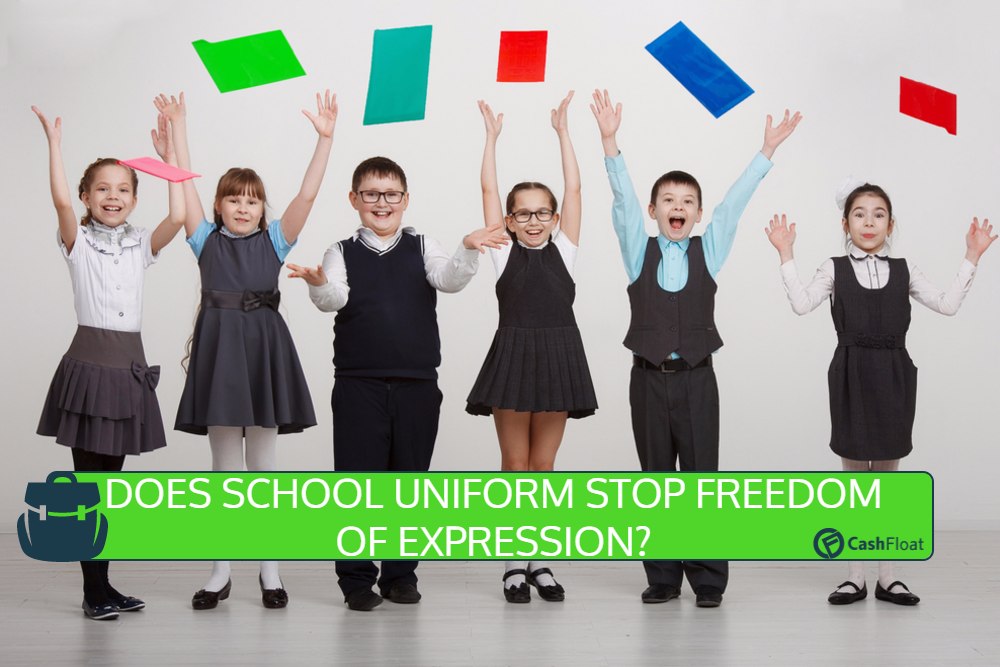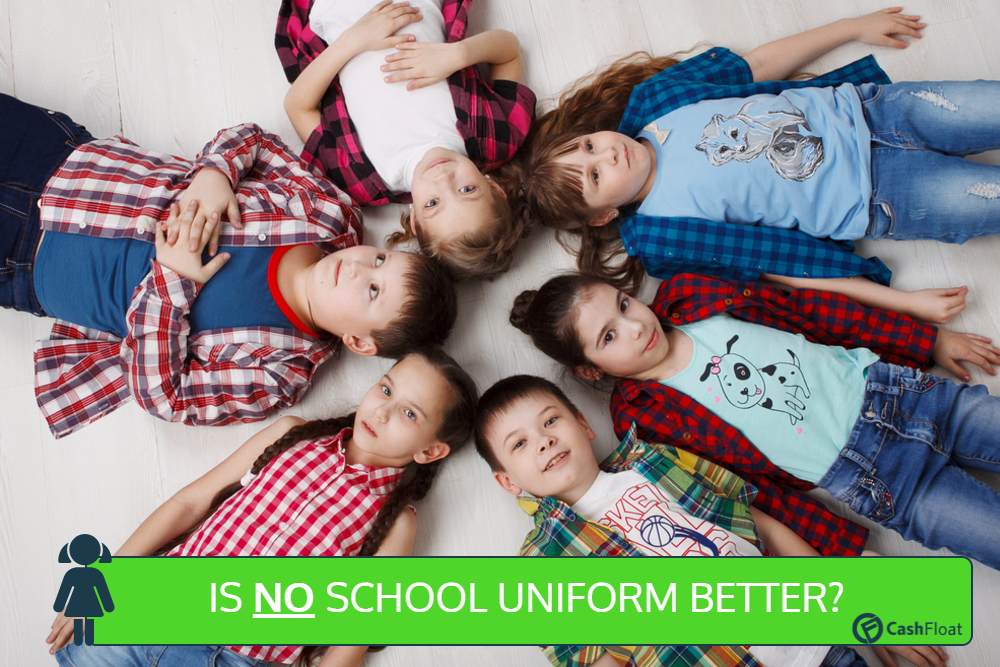School uniform is expensive, and just adds pressure to a parent’s already tight budget. So why don’t we just scrap it? Cashfloat explores the infamous school uniform debate.
- It now costs a typical parent £231,843 to raise a child attending state schools
- School Uniform is expensive, but could help prevent bullying in mild cases
- A practical uniform can ensure that all pupils dress properly at all times, without crossing the school dress policy
We all love our children and want the best for them. Bringing up children has always been an expensive experience. The cost of school uniforms and the debate about whether uniforms are a good idea has been waged for years. In this article, Cashfloat cash loans online lender, takes a look at both sides, and look for opportunities to make savings where school uniform is expensive. Hopefully, with these tips, you won’t need a loan from us to get your kids ready fro school this coming September!
School Uniform is Expensive, Why Bother?
For many of us, one of the biggest investments and most joyful experiences in our lives will be having children. Raising children is expensive. This is regardless of how indulgent we are. Merely the potential of reducing family income by one or both parents sacrificing some earning power to take on child caring duties reduces income. According to research published early in 2016 by the Centre for Economics and Business Research, it now costs a typical parent £231,843 to raise a child attending state schools. This is an increase of 65% since 2003, despite earnings levels being relatively flat for over half that period.

- School clothes
- School uniform debate
- Pros and cons of school uniform
- Do school uniforms prevent bullying
- Why school uniforms are good/bad
- Why school uniform is expensive
- School uniform design
- School uniform shop
- How school uniforms help learning
- Should school uniform be compulsory
- If school uniform is expensive, how can we make it cheaper?
School clothes
With the research being based on the costs until the child “hits 20” that is a whopping sum of over £11,500 per year based on average constant costs. Astonishingly, the research states that costs actually reduce during the age range from five to seventeen years while our children attend school. It often doesn’t feel that way to parents, as it appears to cost more to feed and clothe children as they get older. This may be even before specific items factor into the equation. One specific cost factor hotly debated amongst parents is school uniforms. In this article, we explore the arguments for and against. We will also examine what options parent have in overcoming cost barriers when uniforms are mandatory at many schools as school uniform is expensive.
From the moment our children start school, even kindergarten, clothes become an important consideration for our children. Whether there is a uniform policy or not or even if you are home schooling, we need a wardrobe of clothes which are both practical and hard-wearing. They must also be large enough to cope with the rough and tumble of a five-day week. No longer do we have the option to be relaxed about what we wear around the home. We have to have enough of the right kind of clothing available to turn out our offspring neat and tidy each weekday morning. Being a schoolchild isn’t always conducive to remaining clean. In the research published by the Centre for Economics and Business Research, the cost of education takes the lion’s share of expenditure. This is based on post-18 education fees and costs.
School Uniform Exchange on Facebook
Parents are now turning to school uniform exchange Facebook groups which will help them with kitting out their children for the school year. Many schools require some uniform items to have the school logo on them. These items can turn out to be very expensive and parents can now swap or donate these items. The facebook groups were set up by mums and dads and are split according to schools in the Greater Manchester area and parents can pay up tp £1.50 for a full uniform set in great condition.
School uniform debate
The big subject for many parents is the school uniform question. Are compulsory school uniforms a good thing or a bad thing. This is a big political and sociological debate, with strong opinions on both sides. In the later sections of this article, we will examine some of the specifics of these arguments. What is a fact is that the attitudes to school uniforms and their prevalence have changed over the past 50 years. In the post-war period, it was common for the expanded secondary school sector, comprising grammar schools and secondary modern schools, to have strict uniform policies often comprising formal blazers and school ties for boys and girls with bespoke dresses or gym-slips for girls.

These were often only available from specified local suppliers such as independent drapers or family-run department stores. Specifying uniforms closely in this manner, including bespoke embroidered school badges in many instances gave parents little choice but to pay the high prices this closed market facilitated. Admittedly, most schools permitted a degree of flexibility over the sourcing of shirts and blouses. By only specifying the colour, they can leave parents the flexibility to look for cheaper alternatives than chain stores or markets.
School uniform pros and cons
Times have changed. School uniforms are mandatory at many primary schools now. However, in some instances secondary schools, mainly comprehensive schools in various guises have moved to less formal uniform specifications. The picture varies considerably around the country and within localities. The reason for this variation is that it is the responsibility of the board of governors, usually chaired by the head of the school, to decide on uniform policy – or not.
Pros
The arguments put forward by many teachers, parents, politicians and parents in favour of school uniforms are based on what they regard as the positive attributes of creating a community identity amongst school pupils. Additionally, there’s a perceived equality between all students regardless of the wealth of their parents. This is because they feel that all students wearing the same clothing will prevent arguments and one-upmanship. Whether about the fashion statements, quality or designer-label attributes of clothes, there is no difference with a uniform policy.
Additionally, the uniformity of a practical uniform ensures all pupils dress properly for the needs of their education. Some people, especially in the predominant sector of co-educational (mixed sex) schools, argue that mode of dress encouraged by school uniforms is a good idea.
Cons
Many argue just as passionately against school uniforms – not least the pupils themselves. This is especially as they enter secondary education and become more fashion conscious. Other advocates against school uniform policies include libertarians, including some teachers and educationalists. Some parents also object due to the cost of providing pre-specified school uniforms for their children. The arguments by the libertarians are often the most difficult to rebut as they are largely subjective in nature. However, even these arguments have some merit. There is a lot of opinion that the increasingly prescriptive national curriculum and exam-centric focus of state education in the UK nowadays restricts freedom of expression for our children.
Still, this may to some extent be true, but it has to be recognised that personality development and freedom of expression is not going to be defeated by being required to wear the same uniform as your peers for a few hours each day is a relatively small consideration. This is, of course, in addition to the fact that school uniform is expensive. You don’t want to start the school year off in debt with short term lenders. If so, is school uniform really necessary?
Do school uniforms prevent bullying?
Some sociologists, psychologists and others argue that school uniforms prevent bullying. This may be true in a relatively small proportion of bullying. This is because differences in presentation indicating perceived family background and wealth, to name but a few potential factors may be amongst the armour of the school bully. However, we should acknowledge that children can be very cruel to each other. A school uniform policy, or not, is highly unlikely to make any material difference. The simple fact is that schools need to have proactive anti-bullying policies which staff effectively put into practice.
Both at home and at school it is the responsibility of parents and teachers alike to be alert to potential bullying. We, parents and teachers alike, all need to try to educate our children to avoid bullying themselves and to know what to do if they or their friends are bullied to know how to seek effective help.
Do not be a bystander to bullying! If you see something, say something! Click To TweetSadly, peer group pressure and the potential for bullying doesn’t stop at the school gates. When considering if school uniform is expensive, or if no uniform is specified the clothes you and your child choose for school, you need to consider what happens after school. Firstly, will your child change out of school clothes when they return home? Secondly, will they be bullied or ridiculed if they continue to wear their school clothes in the evenings? Is choosing to, or making, your child wear their uniform or school clothes outside school a good idea? Providing appropriate non-school clothing may save you money by making school clothes stay in good condition and wearable for longer. Thinking carefully about your children’s needs, in and out of school.

Why school uniforms are good or bad
Apart from the freedom of expression arguments, most debate nowadays seems to be in favour of school uniforms, even though school uniform is expensive as an option. However, as with many other subjects, the devil is in the detail. Firstly there is the argument sometimes made that parents have the freedom of choice of which school to send their children to. Varying specialisation in education politicians and councillors will often use this argument. However, the choice is not there for everyone. Those in urban areas may be lucky and live in an area of several schools offering varying types of education and uniform policy. However, in many smaller towns and rural areas there is no choice. It’s one school, take it or lump it.
So, let’s think about what can be good about school uniforms. Firstly, the type and expense of any specified school uniform needs to take into account the local area of a school. Secondly, the ability of parents in the area to meet the cost of whatever uniform is specified. Thirdly, the design of any school uniform (see below) can be critical. Finally, a school uniform which does not force parents to buy bespoke items from an expensive local exclusive retailer can make a big difference to cost. Buying school uniform is expensive if you can’t get some supplies from high street shops.
School Uniforms and Retailers
Moves to more inclusive and economically affordable uniforms by the vast majority of schools has led to increased competition from retailers. Specifying a readily available colour of the shirt, sweatshirt or polo shirt, usually combined with black or dark grey trousers, shorts or skirts means there has been greater availability of such items from more stores resulting in lower prices. The discount retailers Aldi and Lidl have taken on the big supermarkets such as Asda, Sainsburys and Tesco. Along with high street shops, these stores are promoting hard-wearing good quality school clothes. Naturally, this is a big market for the retailers, so they buy in bulk and offer special deals. The best deals will come during the summer holidays to maximise their market share during the “back to school’ promotional period.
School uniform design
Governing bodies of schools need to think carefully about what type, and cost, of uniform, is appropriate for their school. All state schools are required to have parent representatives on governing bodies, usually along with local political appointees. Political appointees should be alert to their potential voters views. A sensible starting point is to consider what styles and colours of uniform items are readily available from competitive shops in the area. Specifying items such as standard white shirts or blouses, or sweatshirts and polo shirts which are readily accessible in a particular colour will help keep costs down. It will also help overcome parental objections on the basis of cost.

Problems with casual uniform
However, the move away from formal – blazer and school tie – to more casual uniforms has brought with it other potential pitfalls and areas for argument. One area often overlooked is footwear. Moving to a relatively economical casual uniform but leaving the matter of footwear addressed is hardly going to eradicate the battles over designer label arguments between pupils and between children and their parents. We can also undo the whole egalitarian ethos of having an easily affordable school uniform if trainers are allowed.
![]() Some “lucky” pupils may have parents able to afford the latest designer label models for this season costing over £100. On the other hand, others may dress in budget priced trainers from a supermarket of a discount outlet. Failing to address such details negates any positive argument about uniform policies avoiding potential conflicts and providing a weapon in the bully’s armoury.
Some “lucky” pupils may have parents able to afford the latest designer label models for this season costing over £100. On the other hand, others may dress in budget priced trainers from a supermarket of a discount outlet. Failing to address such details negates any positive argument about uniform policies avoiding potential conflicts and providing a weapon in the bully’s armoury.
Indeed, many parents, along with paediatricians and podiatrists may argue against the wearing of trainers at school. Shops do not usually sell trainers in half sizes and different width measurements. Similarly, the argument against trainers is that for growing feet, especially for younger children, they do not offer the support and protection more sturdy and formal professionally measured and fitted shoes and sandals do.
School uniform shop
Some parents may also argue that for schools deciding on a uniform policy which includes bespoke items, such as those including an embroidered crest, or including items in colours not readily available a school uniform “shop” can be a good solution. Being able to substantial pre-order quantities in bulk, and avoid the markup (profit) of using nominated retailers can result in an economical solution for parents. Usually, such shops operate on a pre-order basis, with suppliers being able to cut costs by knowing they have guaranteed orders before manufacturing or tailoring to specific needs, such as embroidery. Still, school uniform is expensive in these shops, and buying from high street retailers is often cheaper.

How school uniforms help to learn
A well-designed school uniform should be comfortable to wear throughout the school year. Consequently, specifying the wearing of thick wool blazers and neckties in summer, even a British summer, as was often the case years ago is not a good idea. Hopefully, with a sensible design of uniform the student should feel not be distracted from learning by the uniform in any way.
Should school uniform be compulsory
The argument about whether school uniforms should be mandatory can be discussed on two levels. This is at the school level, or at a national (government) policy for all state schools.
Taking the school-level policy first. It seems that every year there are examples in the media of schools experiencing arguments about school uniforms at the start of the school year. Most of these events are somewhat spurious and totally unnecessary. Often it transpires that some pupils, often supported by their parents, choose to flout an already reasonable and well known school uniform policy. This is unforgivable, especially on the part of the parents. What favours do they think they are doing by supporting their children by opposing the school? Childhood can be difficult enough without having extra stresses being placed upon children.

However, if the school hasn’t put sufficient thought into its school uniform policy, leaving it open to interpretation, the fault lies with the school and its governing body. In such instances, head teacher and their staff should have the common-sense to avoid confrontation with pupils and parents, and look to fixing the problem to prevent the chance of flexible interpretations in the future.
National school uniform policies
On the subject of setting school uniform policies nationally, it is an interesting but probably hypothetical question. If the National Curriculum can dictate the number of hours and method of delivery of specific subjects including English, mathematics and science in all schools, or dictate the provision of school meals and their nutritional value, why shouldn’t there be a national policy for school uniforms?
How can you mitigate the cost of school uniforms?
Many schools operate lost property and recycling of uniform items in an informal shop. This is a great way for unclaimed items from lost property to be made available to parents at bargain prices. Many schools also offer help to parents with limited funds. You should make discreet enquiries with any school before signing up your child to see if such assistance is available.
As with any aspect of household budgeting, it pays to plan ahead. Unless you are one of the small minority of parents considering homeschooling your children, providing them with clothing and footwear for school is a necessity, not a choice. If you are fortunate enough to have a selection of schools for your children to attend, check them out in advance.

As well as making decisions about if they are educationally and socially appropriate for your kids, ask about their uniform policies. Do not forget to include footwear, which can be an expensive outlay and any other extra items which may be required such as a kit for PE and sports. Also, does the school specify a uniform outer coat, or is this left to the freedom of choice? In addition to the fact that school uniform is expensive, you don’t want your child feeling suppressed.
The School Uniform debate Summarised
Finally, with all the facts to hand about the school uniform requirements of your child’s prospective school to hand, hopefully, months in advance, you can start to plan and budget to avoid getting into debt to meet the requirements. Although school uniform is expensive, you now have some tools to overcome that. Possibly, you can start putting money aside to save towards the things, including any uniform, your child will require for the next year at school. As such, you will have the money to hand, without resorting to bank overdrafts or expensive pay day loans, will help you take advantage of special offers and promotions to save even more from your household budget.
Now, start your own school uniform debate now to enable you to plan ahead and avoid struggling or getting into debt.


